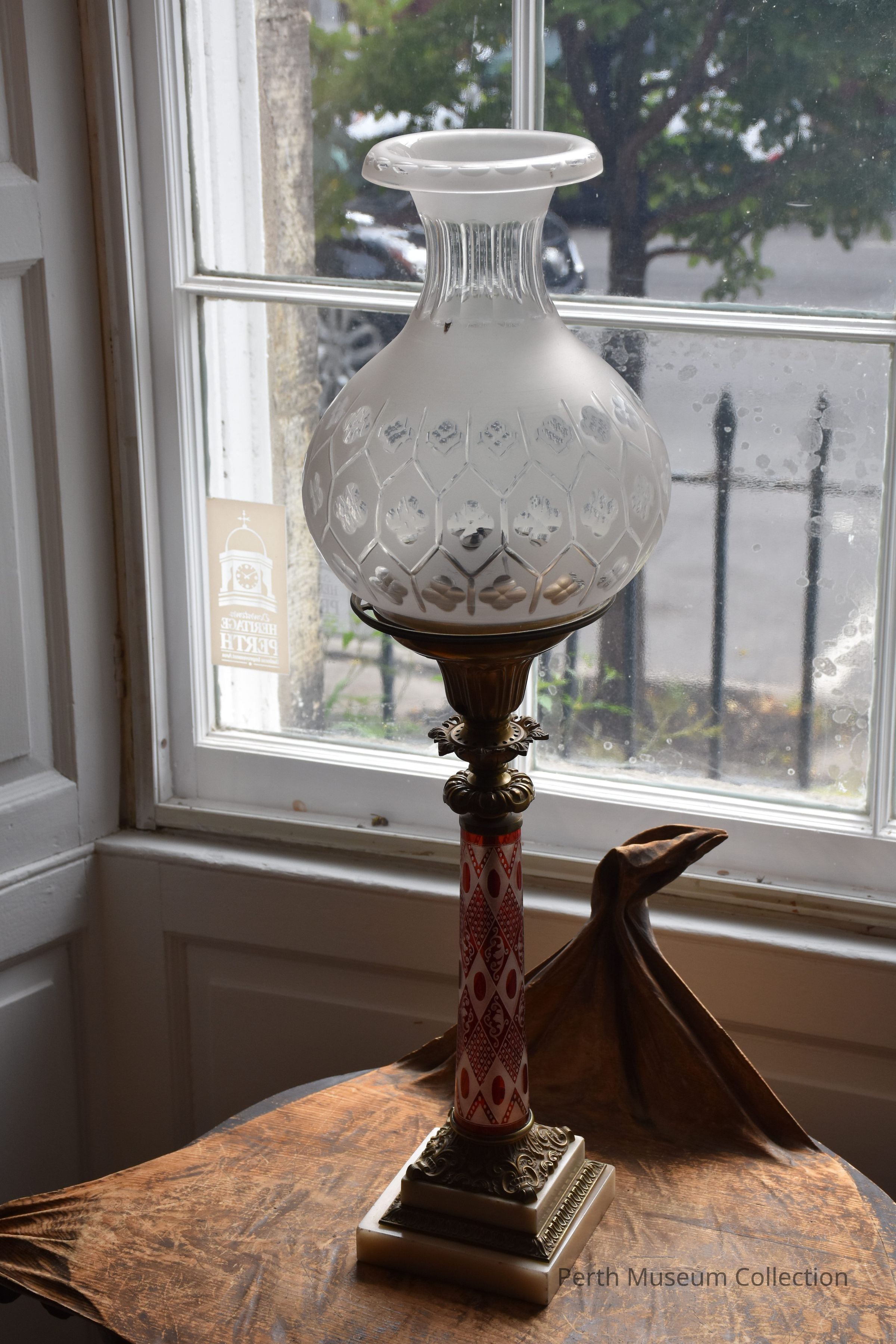Name/Title
Lamp, OilEntry/Object ID
925.32.1a-bDescription
Oil Lamp and Information Sheet:
This was one of the first oil burning lamps in Lanark County. It was owned by Mrs. Boyd Caldwell, of Lanark, Ontario. Sperm whale oil was first used in this lamp, kerosene was used later, and finally the lamp was converted to electricity
This type of lamp was made and used extensively in New England and Britain at the time. The glass might be sandwich glass.
This lamp has an elaborate cased ruby glass columnar support, a double square marble base separated by bands of ormolu and a beautiful and rare etched glass shade that rests on a metal support that surrounds the metal oil font. This type of lamp was commonly called a Sinumbra lamp. It is in perfect condition except for being converted to electricity.
c. 1830-45
"The introduction, in the 1840's, of some American and English patent lamps (the Astral, Sinumbra, Solar and Moderator) opened a new era of elegant home lighting for people who had not been able to afford Argand lamps. These four patent lamps, all with winding wicks and most with chimneys, had Argand burners or modifications of them but could burn a cheaper fluid than spermaceti oil. Common whale or sperm oil, (and eventually kerosene) could be burned in Solars.
The astral was one of the most handsome lamps of all time. It usually had a marble base, brass column and font, tall chimney, and frosted and engraved shade. It was slow to be adopted but became the most popular "best room" lamp of the 1840's and was used well into the 1860's. A pair of "Astrol" lamps were sold at the auction sale of R. Strackweather at Niagara in 1835 and Astral's appeared very frequently in illustrations and paintings of the forties and fifties. Catherine Beecher was still recommending them in her "American Woman's Home" of 1869, although she admitted that the sperm oil that burned best in them was expensive.
The Astral lamp gave an excellent light from its circular wick, and the shallow ring reservoir did not cast a shadow, as the deep font of the Argand had done. The first Astrals contained the ordinary Argand burner but a spiral wick-raiser was added later. The flame was a radiating one.
Astral lamps are seldom seen in Ontario now, and when they are found they have usually been converted, first to kerosene and then to electricity. Sinumbra ("shadowless") lamps, which were first introduced in 1820, belonged to the class of lamps with annular fonts. The oil reservoirs were large rings surrounding the lamp, and they made a rest for the shade. The base was a tall brass column sometimes as high as two feet, surmounted by the ring font and a large ground-glass shade that served as a chimney. The elegant shapes of Sinumbra lamps became prototypes for table lamps, made throughout the era of kerosene, gas and early electricity. They are consequently very familiar to people born in the early years of the 1900's.
The Solar lamp was widely advertised in Upper Canada during the 1840s and '50s. It differed from the Astrol in having, on the burner, a glass or metal cone with a small hole directly over the wick. This drew up the flame and narrowed it. Solars burned well with lard oil, which was cheaper than whale oil, and their construction made them practically smokeless. They were equipped with wick-turners, chimneys and shades. They had a heavy base, often marble, and a metal column of classical design. The font and shade were often ground glass, and prisms hung from the shade-rest. On this continent, they were made principally by Cornelius & Co. of Philadelphia.
Only the best and fanciest of lamps were left in their position for use. All others were removed to the kitchen or pantry where everyday they were cleaned, filled and stored on a shelf. Beside the shelf hung the scissors for trimming wicks, never used for any other purpose. If the pantry was cold, the lamp chimneys had to be warmed before the wick was lit; otherwise they would crack and break.
All types of lamps required careful handling. They could not be tended indifferently or carelessly without great inconvenience and danger. In many houses, women who left other tasks to servants did their own lamp cleaning and filling. Smoke caused by an untrimmed wick or dirty font, the excess oil that left smears on the table or stains on the lamp rug that protected it were a household trial. Lamp rugs, which were generally used, were thick square mats, knitted, crocheted, or embroidered. They not only absorbed excess oil but protected the tables or lamp stands from scratches from scratches when lamps had metal bases or feet. The stands usually had four legs."
From "At Home in Upper Canada" by Jeanne MinhinnickDimensions
Height
75 cmWidth
14.4 cmLength
14.5 cmDimension Notes
Length and width measured at base.
